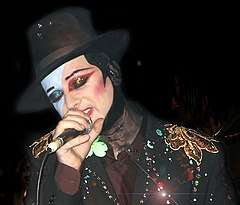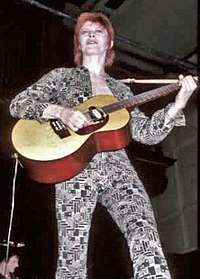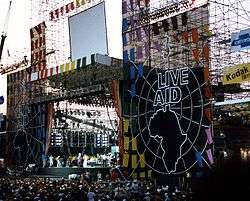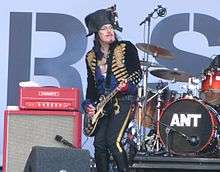New Romantic
The New Romantic movement was a pop culture movement that originated in the United Kingdom in the late 1970s. The movement emerged from the nightclub scene in London and Birmingham at venues such as Billy's and The Blitz.[1] The New Romantic movement was characterised by flamboyant, eccentric fashion inspired by fashion boutiques such as Kahn and Bell in Birmingham and PX in London.[2] Early adherents of the movement were often referred to by the press by such names as Blitz Kids, New Dandies and Romantic Rebels.[3][4]

Influenced by David Bowie, Marc Bolan and Roxy Music, the New Romantics developed fashions inspired by the glam rock era coupled with the early Romantic period of the late 18th and early 19th century (from which the movement took its name). The term "New Romantic" is known to having been coined by musician, producer, manager and innovator Richard James Burgess.[5][6][7][8] In response to a question about being credited with coining the term New Romantic in an interview with The Electricity Club, Burgess said: "Initially I was using three terms - Futurist, Electronic Dance Music (the Landscape singles have EDM printed on them) and New Romantic."[9] Though it was a fashion movement, several British music acts in the late 1970s and early 1980s adopted the style and became known to epitomise it within the press, including Steve Strange of Visage, Duran Duran, Spandau Ballet, A Flock of Seagulls, Classix Nouveaux and Boy George (of Culture Club). Ultravox were also often identified as New Romantics by the press, although they did not exhibit the same visual styles of the movement, despite their link to the band Visage. Japan and Adam and the Ants were also labelled as New Romantic artists by the press, although both repudiated this and neither had any direct connection to the original scene.[4] A number of these bands adopted synthesizers and helped to develop synth-pop in the early 1980s, which, combined with the distinctive New Romantic visuals, helped them first to national success in the UK, and then, via MTV, play a major part in the Second British Invasion of the U.S. charts.
By the end of 1981, the original movement had largely dissipated.[4][1] Although some of the artists associated with the scene continued their careers, they had largely abandoned the aesthetics of the movement. There were attempts to revive the movement from the 1990s, including the short-lived Romo scene.
Characteristics
The New Romantic movement is sometimes characterised as a reaction to the punk rock movement,[10] and was heavily influenced by former glam rock stars of the 1970s such as David Bowie and Roxy Music.[11] In terms of style it rejected the austerity and anti-fashion stance of punk.[12] Both sexes often dressed in androgynous clothing and wore cosmetics such as eyeliner and lipstick, partly derived from earlier punk fashions.[13] This gender bending was particularly evident in figures such as Boy George of Culture Club and Marilyn (Peter Robinson).[10]
Fashion was based on varied looks inspired by historical Romantic themes, including frilly fop shirts in the style of the English Romantic period,[13] Russian constructivism, Bonnie Prince Charlie, French Incroyables and 1930s' Cabaret, Hollywood starlets, Puritans and the Pierrot clown, with any look being possible if it was adapted to be unusual and striking.[14] Common hairstyles included quiffs,[14] mullets and wedges.[10] However, soon after they began to gain mainstream attention, many bands associated with the New Romantic scene dropped the eclectic clothes and make-up in favour of sharp suits.
New Romantic looks were propagated from fashion designers Jane Kahn and Patti Bell in Birmingham[15] and Helen Robinson's Covent Garden shop PX,[1] began to influence major collections and were spread, with a delay, through reviews of what was being worn in clubs via magazines including i-D and The Face.[14] The emergence of the New Romantic movement into the mainstream coincided with Vivienne Westwood's unveiling of her "pirate collection", which was promoted by Bow Wow Wow and Adam and the Ants, who were managed by her then-partner Malcolm McLaren.[16] However, the post-punk Adam Ant himself has always denied being a New Romantic, and reiterated this in 2001[17] and again in 2012.[18]
The band Japan also denied any connection with the New Romantic movement, having adopted an androgynous look incorporating make-up ever since their inception in the mid-1970s at the tail-end of the glam rock era, many years before the New Romantic movement began. In an October 1981 interview, vocalist David Sylvian commented, "There's a period going past at the moment that may make us look as though we're in fashion."[19] In another interview, he stated "I don't like to be associated with them (New Romantics). The attitudes are so very different." Of Japan's fashion sense, Sylvian said, "For them (New Romantics), fancy dress is a costume. But ours is a way of life. We look and dress this way every day."[20]
Similarly, the electronic duo Soft Cell also denied any connection to the New Romantic scene. In an interview published in January 1984, keyboardist Dave Ball reflected back on their first year of success (1981) and stated, "At this time we were linked to the whole New Romantics thing, but we were never a part of that. It was just a trendy London club thing with Steve Strange."[21]
While some contemporary bands, particularly those of the 2 Tone ska revival, wrote lyrics addressing social issues such as unemployment and urban decay, New Romantics adopted an escapist and aspirational stance.[22] With its interest in design, marketing and image, the movement has been seen by some as an acceptance of Thatcherism; style commentator Peter York even suggested that it was aligned with the New Right.[23]
Names
In its early stages the movement was known by many names, including "new dandies", "romantic rebels", "peacock punk", "the now crowd", "the futurists", "the cult with no name"[1] and eventually as the "Blitz Kids". As the scene moved beyond a single club the media settled on the name New Romantics.[4][24]
History
Origins

The New Romantic movement developed almost simultaneously in London and Birmingham.[25] In London it grew out of David Bowie and Roxy Music themed nights, run during 1978 in the nightclub Billy's[26] in Dean Street, London.[27] In 1979, the growing popularity of the club forced organisers Steve Strange and Rusty Egan to relocate to a larger venue in the Blitz,[28][29] a wine bar in Great Queen Street, Covent Garden, where they ran a Tuesday night "Club for Heroes".[1] Its patrons dressed as uniquely as they could in an attempt to draw the most attention.
Steve Strange worked as the club's doorman and Egan was the DJ at the Blitz. The club became known for its exclusive door policy and strict dress code. Strange would frequently deny potential patrons admission because he felt that they were not costumed creatively or subversively enough to blend in with those inside the club. In a highly publicised incident, a drunken Mick Jagger tried to enter the club, but Strange denied him entry.[30] The club spawned several spin-offs and there were soon clubs elsewhere in the capital and in other major British cities, including Manchester, Liverpool and Birmingham.[11]
While still at Billy's, Strange and Egan joined Billy Currie and Midge Ure of Ultravox to form the band Visage. Before forming Culture Club, Boy George and Marilyn worked as cloakroom attendants at the Blitz.[31] The video for David Bowie's 1980 UK number one single "Ashes to Ashes" included appearances by Strange with three other Blitz Kids and propelled the New Romantic movement into the mainstream.[11]
In Birmingham the origins of the New Romantic movement lay in the opening in 1975 of the Hurst Street shop of the fashion designers Kahn and Bell,[32] whose elaborate and theatrical designs brought together futuristic visual elements and influences as diverse as Egyptian, African and Far Eastern art,[33] and would largely define the movement's look.[34] By 1977 a small scene featuring Jane Kahn and Patti Bell themselves, Martin Degville, Boy George and Patrick Lilley had emerged in pubs such as The Crown and clubs such as Romulus and Barbarella's.[35]
Styles of music
Many bands that emerged from the New Romantic movement became closely associated with the use of synthesizers to create rock and pop music, which has led to the widespread misconception that synthpop and the New Romantic movement were synonymous. Synthpop was prefigured in the 1960s and 1970s by the use of synthesizers in progressive rock, electronic art rock, disco, the "Kraut rock" of bands like Kraftwerk, the three albums made by Bowie with Brian Eno in his "Berlin period", and Yellow Magic Orchestra's early albums.
After the breakthrough of Tubeway Army and Gary Numan in the British Singles Chart in 1979, large numbers of artists began to enjoy success with a synthesizer-based sound and they came to dominate the pop music of the early 1980s. Bands that emerged from the New Romantic scene and adopted synthpop included Duran Duran, Visage, and Spandau Ballet.[36]
Early synthpop has been described as "eerie, sterile, and vaguely menacing", using droning electronics with little change in inflection. Later the introduction of dance beats made the music warmer and catchier and contained within the conventions of three-minute pop.[37] Duran Duran, who emerged from the Birmingham scene, have been credited with incorporating a dance-orientated rhythm section into synthpop to produce a catchier and warmer sound, which provided them with a series of hit singles.[37]
While many groups associated with the New Romantic movement used synthesizers, some avoided them entirely or made limited use of them. Culture Club, frequently considered part of the movement produced a sound that combined elements of Motown, the Philly soul and lovers rock.[38] Adam and the Ants and Bow Wow Wow used the African influenced rhythms of the "Burundi beat".[39]
The second British invasion
In the US the cable music channel MTV reached the media capitals of New York City and Los Angeles in 1982.[40][41] Style-conscious New Romantic synthpop acts became a major staple of MTV programming. They would be followed by many acts, many of them employing synthpop sounds, over the next three years, with Duran Duran's glossy videos symbolising the power of MTV and this Second British Invasion. The switch to a "New Music" format in US radio stations was also significant in the success of British bands.[41]
This 80s invasion had been prefigured in May 1981 when Spandau Ballet, house band of London's Blitz club, had flown to New York City to stage not only a live gig but a fashion show by the Axiom collective of designers, who included Sade Adu. These former Blitz Kids, "21 in number and 21 their average age"[42] came by invitation of Jim Fouratt who hosted the event at the Underground club.
During 1983, 30% of the US record sales were from British acts. On 18 July 1983, 18 singles in the top 40, and 6 in the top 10, were by British artists.[41] Newsweek ran an issue which featured Annie Lennox and Boy George on the cover of one of its issues, with the caption "Britain Rocks America – Again", while Rolling Stone would release an "England Swings" issue with Boy George on the cover.[41] In April 1984, 40 of the top 100 singles, and in a May 1985 survey 8 of the top 10 singles, were by acts of British origin.[43][44]
Decline and revivals
Music journalist Dave Rimmer considered the Live Aid concert of July 1985 as the peak for the various acts that rose from the New Romantic scene of the early 80s, commenting that after which "everyone seemed to take hubristic tumbles".[45] Simon Reynolds also notes the "Do They Know Its Christmas" single in late 1984 and Live Aid in 1985 as turning points, with the acts that the movement spawned as having become decadent, with "overripe arrangements and bloated videos" for songs like Duran Duran's "The Wild Boys" and Culture Club's "The War Song".[46] The proliferation of acts using synthesisers had led to an anti-synth backlash, with groups including Spandau Ballet, Soft Cell and ABC incorporating more conventional influences and instruments into their sounds by 1983.[47]
An American reaction against European synthpop and "haircut bands" has been seen as beginning in the mid-1980s with the rise of heartland rock and roots rock.[48] In the UK, the arrival of indie rock bands, particularly The Smiths, has been seen as marking the end of synth-driven new wave and the beginning of the guitar rock that would come to dominate rock into the 1990s.[49][50] By the end of the 1980s many acts had been dropped by their labels and the solo careers of many artists who had been associated with the New Romantic scene gradually faded.[51]
In the mid-1990s, the New Romantic era was the subject of nostalgia-oriented club nights — such as the Human League-inspired "Don't You Want Me", and "Planet Earth", a Duran Duran-themed night club whose promoter told The Sunday Times "It's more of a celebration than a revival".[52] In the same period it was also an inspiration for the short-lived Romo musical movement. It was championed by Melody Maker, who proclaimed on its front cover in 1995 that it was a "future pop explosion" that had "executed" Britpop, and including bands Orlando, Plastic Fantastic, Minty, Viva, Sexus, Hollywood and DexDexTer. None made the British top 75,[53] and after an unsuccessful Melody Maker-organised tour, most of the bands soon broke up.[54]
See also
Notes
^ During the New Romantic period, two of four Ultravox members—frontman Ure and keyboardist Currie—were also in the then six person group Visage.
References
- Johnson, David (4 October 2009). "Spandau Ballet, the Blitz Kids and the birth of the New Romantics". The Observer. London, England: Guardian Media Group. Retrieved 24 July 2011.
- Persson, Laura Borrelli (11 September 2015). "Duran Duran's Nick Rhodes Talks New Wave, David Bowie, and Hedi Slimane's Saint Laurent". Vogue. New York City: Condé Nast. Retrieved 7 December 2018.
- "BLITZ KIDS, Shapers of the 80s". Shapersofthe80s.com. Retrieved 28 July 2014.
- Cateforis, Theo (2011). Are We Not New Wave?: Modern Pop at the Turn of the 1980s. Ann Arbor, Michigan: University of Michigan Press. pp. 47–8. ISBN 0-472-03470-7.
- "Adventures in synth". The Guardian. 1 May 2008.
- "Richard James Burgess, CEO, American Association of Independent Music". SouthWales.ac.uk.
- "Richard James Burgess's schedule for 2019 AIMP Indie Music Publishing Summit".
- "Richard James Burgess". SoundExchange.
- "RICHARD JAMES BURGESS Interview". 27 July 2010.
- Borthwick, Stuart; Moy, Rob (2004). Popular Music Genres: an Introduction. Edinburgh, Scotland: Edinburgh University Press. p. 132. ISBN 0-7486-1745-0.
- Buckley, David (2005). Strange Fascination: David Bowie, the Definitive Story. London, England: Random House. p. 318. ISBN 0-7535-1002-2.
- Evans, Richard (2009). Remember the 80s: Now That's What I Call Nostagia!. London, England: Anova Books. p. 16. ISBN 1-906032-12-2.
- Steer, Deirdre Clancy (2009). The 1980s and 1990s. New York City: Infobase Publishing. p. 37. ISBN 1-60413-386-4.
- Steele, Valerie, ed. (2010). The Berg Companion to Fashion. London, England: Berg Publishers. p. 525. ISBN 1-84788-592-6.
- "Kahn and Bell Shop". New Sounds New Styles. 1981. Retrieved 7 December 2018.
- O'Byrne, Robert (2009). Style City: How London Became a Fashion Capital. London, England: Frances Lincoln Ltd. p. 77. ISBN 0-7112-2895-7.
- Ant, Adam (2001). "I always consider myself to be in a punk band and a punk artist". I Love 1981, at 02:44mins. BBCManchester, producer Juliet Glaves. Retrieved 27 May 2019.
- Aitkenhead, Decca (19 February 2012). "Adam Ant: To be a pop star you need sex, subversion, style and humour". The Guardian. London, England: Guardian Media Group. Retrieved 26 May 2012.
- Rimmer, Dave (October 1981). "Japanese Boys". Smash Hits. Vol. 3 no. 22. London, England: EMAP Metro. pp. 42–43.
- "Rolling Stone Random Notes". The Tuscaloosa News. Tuscaloosa, Alabama: Gannett. 17 July 1981. p. 6.
- Martin, Peter (January 1984). "Soft Cell: That Was Then But This Is Now". Smash Hits. Vol. 6 no. 1. p. 6.
- Reynolds, Simon (2005). Rip It Up and Start Again Postpunk 1978–1984. London, England: Faber and Faber. pp. 326 and 410. ISBN 0-571-21570-X.
- Borthwick, Stuart; Moy, Roy (2004). Popular Music Genres: an Introduction. Edinburgh, Scotland: Edinburgh University Press. p. 124. ISBN 0-7486-1745-0.
- Russell, Tony, ed. (1983). Encyclopedia of Rock. Wingdale, New York: Crescent Books. p. 119. ISBN 0-517-40865-1.
- Johnstone, Sam (2013). "New Romantics". In Childs, Peter; Storry, Michael (eds.). Encyclopaedia of Contemporary British Culture. London, England: Taylor & Francis. p. 363. ISBN 978-1134755547.
- "Revolution, Shapers of the 80s". Shapersofthe80s.com. Retrieved 28 July 2014.
- "Steve Strange". Showbiz Wales/Southeast Hall of Fame (BBC). August 2009. Archived from the original on 27 July 2010.
- Johnson, David (4 October 2009). "Spandau Ballet, the Blitz kids and the birth of the New Romantics". The Guardian. London, England: Guardian Media Group. Retrieved 11 January 2019.
- "'Erromantiko berriak' entzungai – Tolosaldeko ataria" (in Basque). Ataria.eus. 22 December 2017. Retrieved 11 January 2019.
- Strange, Steve (10 March 2002). "The most decadent nightclub in the world". The Mail on Sunday. London, England: Daily Mail and General Trust. Archived from the original on 30 April 2011. Retrieved 26 July 2011 – via Highbeam Research.
- O'Byrne, p. 81
- Rimmer, Dave (2003). New Romantics: The Look. London: Omnibus Press. pp. 105–106. ISBN 0711993963.
- "Bustier". Victoria & Albert Museum. Retrieved 30 June 2013.
- Rhodes, Nick (22 April 2006). "How we opened the door to the 1980s". The Daily Telegraph. London, England: Telegraph Media Group. Retrieved 30 June 2013.
- Rimmer, pp. 100–102
- Reynolds, pp. 334–5
- "Synth pop". AllMusic. Archived from the original on 11 March 2011..
- Reynolds, pp. 412–3.
- Reynolds, pp.306-7, 311
- Cateforis, Theo. The Death of New Wave (PDF). Archived from the original (PDF) on 23 July 2011.
- Reynolds, pp. 340 and 342-3
- "First Blitz invasion of the US, Shapers of the 80s". Shapersofthe80s.com. Retrieved 17 March 2017.
- "UK acts disappear from US charts". BBC News. London, England: BBC. 23 April 2002. Retrieved 15 May 2011.
- Denisoff, Von R. Serge; Schurk, W. L. (1986). Tarnished Gold: the Record Industry Revisited. Piscataway, New Jersey: Transaction Publishers. p. 441. ISBN 0-88738-618-0.
- Rimmer, p. 126
- Reynolds, p. 517.
- Reynolds, p. 342
- Reynolds, p. 535
- Erlewine, Stephen Thomas. "The Smiths". AllMusic. Archived from the original on 16 July 2011.
- Erlewine, Stephen Thomas. "R.E.M." AllMusic. Archived from the original on 28 June 2011.
- Reynolds, p. 523
- Langan, Steve (19 November 1995). "Worst of Times". The Sunday Times. London, England: News UK. p. 1.
- Simpson, Dave (6 August 2009). "The scenes that time forgot". The Guardian. London, England: Guardian Media Group. Retrieved 26 July 2011.
- Erlewine, Stephen Thomas (2002). "Orlando". In Bogdanov, Vladimir; Woodstra, Chris; Erlewine, Stephen Thomas (eds.). AllMusic Guide to Rock: the Definitive Guide to Rock, Pop, and Soul (3rd ed.). Milwaukee, Wisconsin: Backbeat Books. pp. 828–9. ISBN 0-87930-653-X.
Further reading
- Peter Childs, Mike Storry (1999). Taylor & Francis (ed.). Encyclopedia of Contemporary British Culture. pp. 181–184, 363, 562. ISBN 978-0-415-14726-2.
- Steve Strange (2003). Blitzed! The Autobiography of Steve Strange. Orion. ISBN 978-0-7528-4936-2.
External links
- BBC News | REVIEWS | Romantic revival
- Walker, John. (1992) "New Romantics". Glossary of Art, Architecture & Design since 1945, 3rd. ed.
- YouTube playlist featuring New Romantic music

